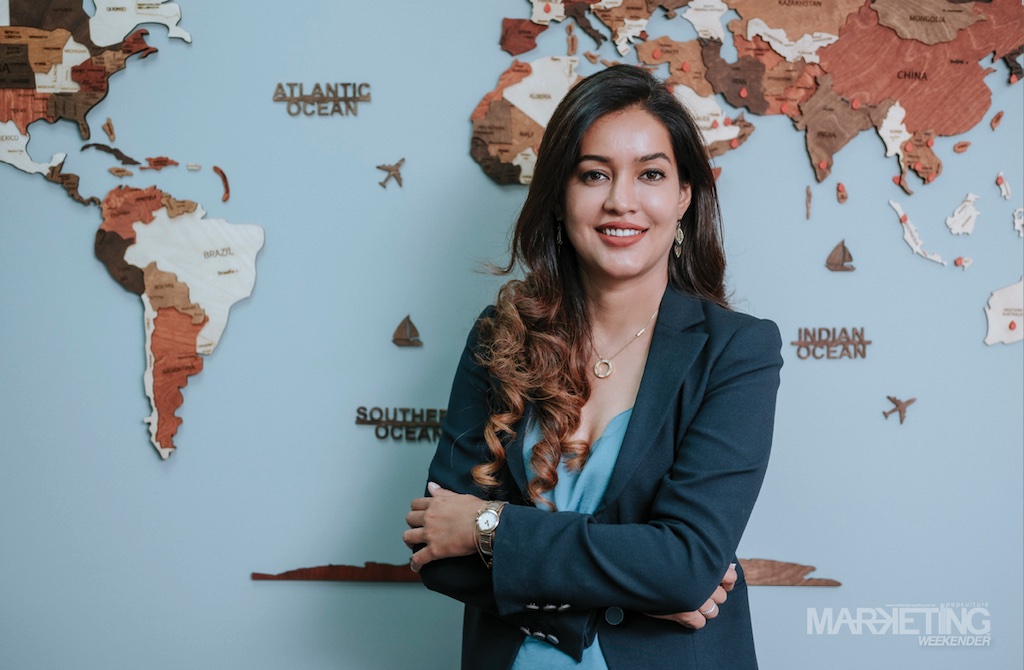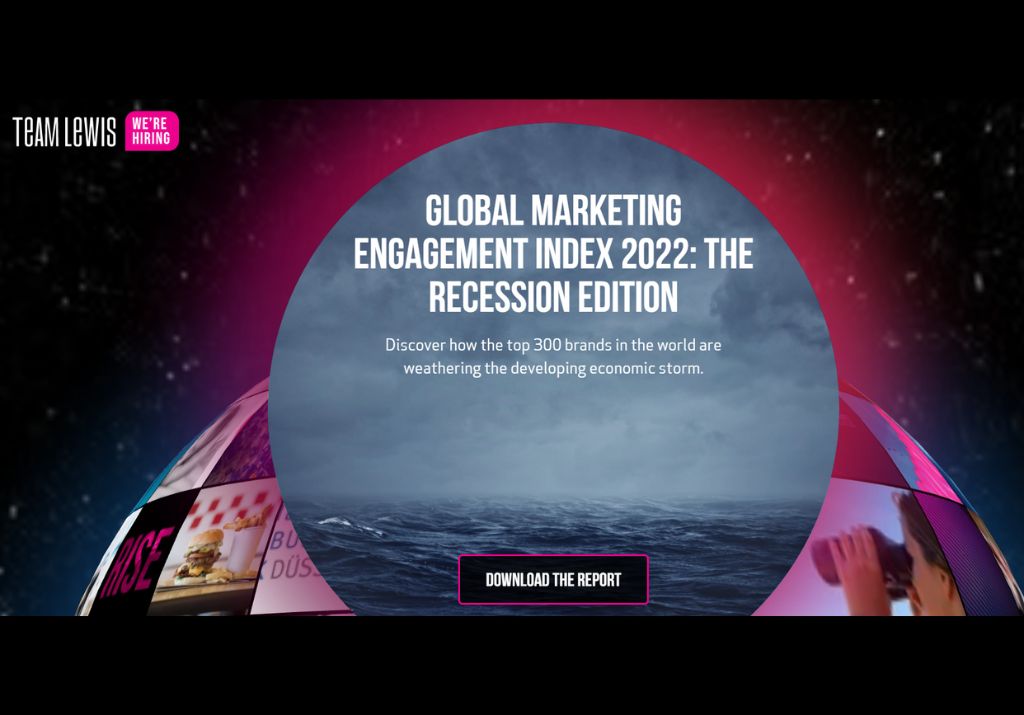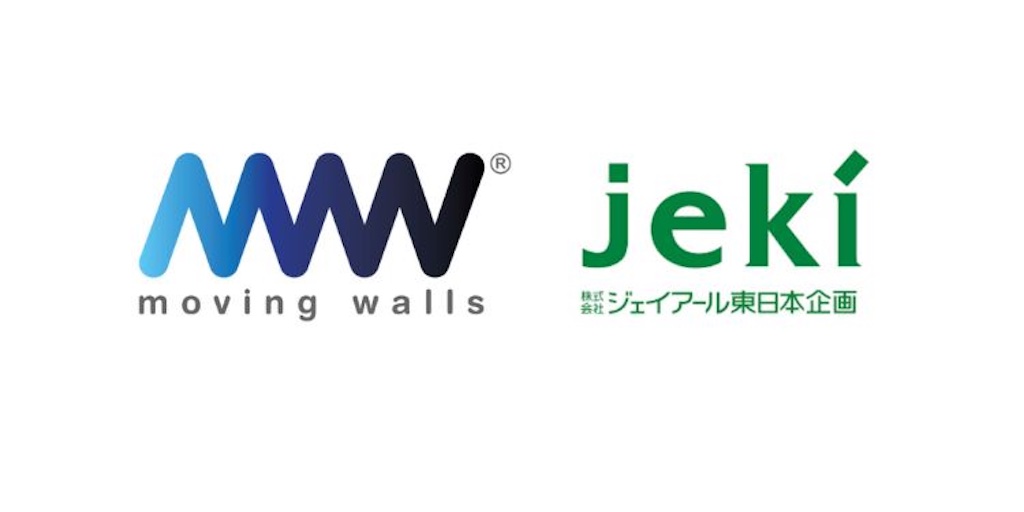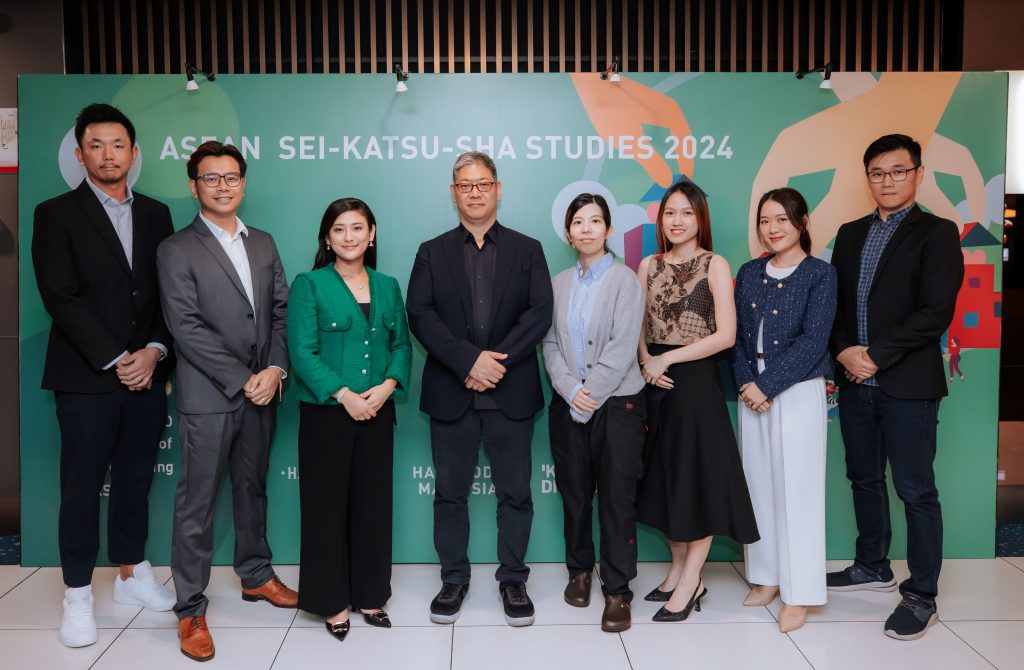The Firefly management team, from left: Head of Engineering & Maintenance, Azmi Jusoh; Head of Flight Operations, Caption Mohd Ariffathillah Jamel; Head of Human Resource, Ismail Fahmi Abdul Rahman; Head of Ground Operations, Anil Nair; Head of Network & Revenue Management, Sufira Ibrahim; Chief Financial Officer, Nadiah Abdul Razak; Chief Executive Officer, Philip See; Head of Sales, Muizzuddin Mahmud; Head of IT & Distribution, Venice Chong and Head of Marketing & Communications, Izra Izzuddin.
This article was first published in Issue 241, January 2020 of Marketing Magazine Asia. To download a pdf copy of the full magazine, click here.
Firefly is a 12-year old subsidiary of the Malaysia Aviation Group that operates from its main hub Sultan Abdul Aziz Shah Airport in Subang and offers predominantly domestic flights. A vibrant and friendly airline that goes beyond boundaries, Firefly is a preferred choice for corporate travellers who find the value in flying from an airport that is closer to central Kuala Lumpur and is also known for being a full-service airline with competitive prices.
Situated in a humble office inside of Citta Mall, conveniently less than five kilometers away from Subang Airport, is Firefly’s headquarters. The quirky office’s lobby is designed to imitate the entrance and exits of an aircraft, and its employees are all on the same floor.
MARKETING Magazine had the privilege of sitting down with Firefly’s Management team to find out what they’re up to as the new decade approaches and dive deep into its philosophy, operations and marketing strategy with Firefly CEO, Philip See, who was appointed earlier this year, and Firefly’s Head of Marketing and Communications, Izra Izzuddin. (At the time this article was published, Izra Izzuddin is no longer the Head of Marketing and Communicatoins at Firefly and is now the Director of Marketing and Communications at Touch n’Go Digital)

Starting off with you, Philip, you were appointed in January this year which means it’s your first anniversary as the CEO. What do you know now that you didn’t in January?
Philip: I didn’t know it was going to be such a tough job (laughs). I know better now that if you embrace and understand the details of the business, you will enjoy the business and the work much more. I was a strategy guy, mostly thinking about the big picture. When I took on this role, I realised I couldn’t just do that, and that I really had to understand the operational and people side. Also, I knew managing people was very important but I didn’t know it was that important. I’ve learned that it’s super critical to manage people and manage teams, and it was something I didn’t know required so much time and investment.
Is there something new about how you manage people that you’ve picked up with your role?
Philip: You have to be very situational when it comes to managing people. Sometimes you let go and sometimes you have to even micromanage. It’s about the balance of having trust but also a healthy level of skepticism. For me, the key learning was to be very situational in how I manage and interact with people.

What are some of the different approaches you had to take when transforming the business at Firefly compared to your experience in business turnaround at MAS?
Philip: To be very clear, in this one year, we haven’t really completed the transformation and I’ll even say that the transformation will never be complete, because its an evolving program that’s always looking at ways to reinvent itself. Firefly is very different from MAS or MAB and because it’s smaller, decision making is much faster. Teams here are more open and agile, which is one of the advantages of any organisation like this, where everyone sits on the same floor, where the teams work very well together, and things move much faster.
But with the small size also comes the challenge of scale. The question on trying to pursue growth, innovation or investments, becomes more of a different challenge altogether. So you have to really hyper innovate and think out of the box if you want to drive change.
“The key priority here is to build an agile organisation and to essentially be able to create some stability while injecting creativity throughout the process”
– Philip See, Firefly CEO
On how you said the transformation never ends, what would you say is the role of a CEO in an environment like this?
Philip: If you look at the past 12 years of Firefly’s history, it’s had its ups and down – at one time it was expanding, then it contracted. So really for me, you must have the license to grow. The key priority here is to build an agile organisation and to essentially be able to create some stability while injecting creativity throughout the process.
How has Firefly’s business been since resuming flights to Singapore via Seletar airport?
Philip: Before Seletar, we were operating 10 flights a day and the resumption was 6 flights. So we’re not yet back to full production of where we were. The customers that travel on that route are mostly corporate because they love the fact that the airport is so convenient. But since it’s a new airport, it takes time to develop and create awareness as a whole. What we see is a lot more repeat customers, because once you’ve tried it, you typically never go back to Changi.
So really for us it’s about a steady climb back to its full capacity and potential.
Firefly uses ATR aircraft, meant for low and short distance. Are there plans to use new aircraft and/or fly to further destinations?
Philip: There are no immediate plans for new aircraft. The strategy in the immediate term is based on the fact that ATRs have a range of one to one and a half hours of flying. Hence, for us, our growth plan is mainly to improve connectivity from secondary cities all across Peninsular Malaysia. That’s why this year we launched Penang-Kuantan and our JB to Kota Bahru flights.
The immediate strategy is to strengthen our Subang Hub and consolidate that, while beginning to do some interesting expansions in major secondary cities in Peninsular Malaysia.
How do you feel about self-service (self-check in booths, self-service baggage drop-offs)? Will Firefly be introducing more self-service options at airports?
Philip: We operate mostly from Subang, which is a small airport. So for our customers, time is super important. Being able to offer our customers time efficiency – getting them in and out really fast – is very critical. The interesting thing you’ll find here is that because our flight time is short, the ground operations experience is very important. So how do we begin all these self-service elements? We can’t look at it as doing it just at the airport but also pre-airport. So when we think about the customer experience where time is important, we ask ourselves how are we going to deliver the efficiency right at the beginning of the whole process.
At the Subang airport, there are self check-in kiosks already in place.The challenge is, in order to take it to the next level with for example, self check-ins at the gates itself, it requires investment in technology. So the ROI has to be played in view of how simple things already are and the case to invest more, diminishes over a period of time. Since you’ve already reduced the time, saving an extra 30 seconds by investing X amount isn’t easily justified.

Adding to this question was Firefly’s Head of Ground Operations, Anil Nair…
Anil: Currently if you fly with Firefly, you can check-in earlier and print your boarding pass at the airport. However, we want to move towards a paperless process. But for this, we aren’t the only player in the airport. I think AirAsia has tried something before, by installing their own hardware. However, the lead needs to come from the airport itself. We have raised this with Malaysian Airports as there is a National Aviation Consultative Council.
How do your employees react to these changes?
Philip: Generally our employees love the concept of automation. An interesting thing about the airline industry is that a lot of the functions are required from a regulatory standpoint. Here, automation is designed to make their jobs much easier, allowing them to spend more time doing value-adding work rather than doing manual actions and activities. People tend to embrace it because there are a lot of other parts of the business that are growing and the intention is to re-skill and move people to other aspects of the job where there is demand.
Do you think it’s more difficult for employees to accept changes than customers?
Philip: I think there’s a venn diagram where they both intersect. The key really is the right change at the right time and how you deliver it.
Anil: I think whatever change we implement is to the benefit of the customer, making their experience more simple. With employees, when something new comes up, it’s something new they have to remember.
What kind of disruptions do you foresee the airline industry facing in this new decade?
Philip: I see three things really.
One is the environment, the really big push for sustainability.
Second, I feel the biggest disruption will be the brand. There is a huge perception that “I fly because of the brand” but I believe over time, as customers have more choice, the fear is the commoditization of all these experiences.
The third biggest one is people. In terms of resources and organisation, the employee base is changing. Managing, retaining and building talent is going to be the biggest disruption to the business.
Anil: I think another concern is our competition, not airlines wise but ground transport. For example, in Johor if they start the high speed rail, which could cut the journey to a little over two hours, the question on convenience when it comes to the whole process of flying which includes getting to an airport in time, checking in and going through more than one security checkpoint, over the process of taking the train.
How does big data change the way airlines operate? Can we foresee prices being changed depending on who’s purchasing an airline ticket?
Philip: The bigger challenge here is analysing and using the data correctly. In the airline industry, there’s already quite a bit of data. More importantly, the question is whether or not the data can be collaboratively used with other relevant partners.
For me, fundamentally big data is about analysing it and then using it to make structural calls.
If we can use data to make forecasting and predictions, that is super important, be it on the maintenance side for how we do aircraft maintenance, managing disruptions in travel, like seeing a certain weather pattern and realising an indication of possible disruption and also how we manage operations in terms forecasting the demand.
What’s the plan for Firefly’s mobile app?
Philip: There will be a redesign of the app this year and for us currently our penetration is pretty decent compared to others and we really want to double that penetration. It’s very important to us because it enables us to build a direct relationship with our customers through the device they use all the time.
Are there any 2020 collaboration plans in Firefly’s business strategy?
Philip: So when we frame it from a collaboration standpoint, we always look at it through the financial lens. Plus, Firefly is relatively small compared to other airlines and it can be said that our priority is time. So when we think about collaborations, it’s about those that enable us to deliver better time efficiencies.
Last mile connections and hotels in all shapes and forms are super important. Essentially, a lot of the partnerships that enable us to expand distribution is very important. So we always look at three areas when exploring partnerships. One that delivers last mile connections well; the other is along the lines of hotels and theme parks, anything that elevates the travel experience and finally, whatever enables us to expand our distribution.
What are the upcoming innovations on products, services and business development you believe Firefly should implement?
Philip: So how we go about this is by being very clear on what our core segments are. When you think about what works in Subang, our core segments are corporate or pleasure; it’s also about groups of people such as senior citizens; it’s also about segments like young families. So when we think about product development, we have to factor these in. We can’t disclose everything that’s currently in the pipeline, but we always think in terms of these segments while also making sure there is universal application. For example, we recently did an installment program where you can pay in installment for six months, which is mostly targeted at big families.
Izra, can you describe Firefly’s marketing strategy in three words?
Izra: I would say dynamic, innovative and convenient.
Firefly’s new campaign – “Discovery – See It, Hear It, Sense It, Feel It, Touch It, Taste It” – can you tell us more about how this fits in with both Firefly’s 2020 direction and Visit Malaysia 2020?
Izra: The interesting part about this campaign is, we actually introduced it even before Tourism Malaysia introduced the VMY2020 direction. Every year we introduce a direction for our marketing strategy and it stays for one year. This time, when we heard about VMY’s 2020 direction, we as a team decided to extend it to 2020.
The campaign is pretty much about domestic travels. As you know, Firefly is a predominantly domestic airline and we only have about three regional routes. Looking at the six pillars in the campaign title, we made it all about discovering the gems of our country. So it goes back to what we need to know and appreciate more about Malaysia, especially in Peninsular.
This is not to say we are not talking about Sabah and Sarawak, but because there is MAS Wings and Malaysia Airlines on that side of the country, we work together to contribute to the whole direction, hence Fly Malaysia, as sort of a group brand campaign for 2020.
Specifically in terms of discovery, I would say there are three key things that we’re looking at for next year that complement the six pillars that we have: Leisure, Medical and Education tourism.
How does Firefly compete with its competitors in, through marketing?
“We position ourselves as having our own strengths while other airlines have their own. However, I will say there are a few elements that we have and our competitors don’t.”
Izra: The airline industry alone is very competitive. I wouldn’t say that we’re not competing with anyone at all, instead we focus on complementing the market’s needs.
We position ourselves as having our own strengths while other airlines have their own. However, I will say there are a few elements that we have and our competitors don’t. We are not low cost, but our price is competitive and we offer full service.
We make sure that when people look for flights and land on our website, it is user friendly enough because 90 percent of our bookings are made on our website and mobile app.

Touch n’Go Digital as of 6 January, 2020.
Hence we carry that ‘beyond convenience’ philosophy up to the payment stage and beyond. As Philip mentioned, we’ve also just introduced our easy payment which is an instalment plan as low as 500 ringgit, allowing consumers to pay monthly within six months. That alone is attractive enough to target the mass market. This is how we’re looking at bringing what others don’t have.
Besides that, we focus on our people, making sure the service and warmth they provide influences our consumers’ trip from the ground to the air.
Another obvious point I’d like to add is that we’re located in Subang – that’s our winning factor.
I’m curious, how do airlines feel about tertiary booking websites? Is it a good thing they exist so there are more platforms promoting your flights or would you prefer if the process was streamlined through just your website?
Izra: Definitely, we would like people to come to the website because we are the main channel and because we own the business here. But you also have to work with partners like Traveloka, Expedia and Skyscanner as they complement the business and the revenue we get. For example, we’re currently working with Traveloka for marketing campaigns.
We’re ensuring they don’t dilute the business that we are making just because consumers can look for Firefly elsewhere. So we make sure that what we offer on our website is different. We tend to offer promotions exclusively on our website, such as free lounge access.
What are some of the most successful marketing campaigns Firefly has executed?
Izra: I would say when it comes to successful marketing campaigns, we are not just looking at it from a revenue driven perspective but also noise driven. One of the biggest was “Live the High Life with Firefly” which involved three celebrities and even featured a competition where winners could go on a holiday with these celebrities. The celebrities we used in the campaign represented the three segments we focus on and it was a huge success. Another one was in 2017 where everyone gets a prize. It was set up in a way that after all the noise we made in 2016, in 2017 it was all about the customers. We made sure and as long as they bought one ticket, they would get something. This campaign was what won us the Consumer Awards 2017 and was also submitted and won at the Malaysian CMO Awards 2018.
(Editor’s Note: Izra also won a Special Mention Award at the Malaysian CMO Awards in 2018)
This year we did the “Dump your Ex” campaign where we were able to get 54% of consumers from the other airline that is also flying out of Subang Airport and the remaining 46% consists of a combination from the other airlines flying out of klia2 and KLIA.
What other plans do you have for Firefly’s Marketing strategy this year?
Izra: Yes, since we are not as big as the other airlines, we can’t work on everything on our own. We are working with federal and state tourism as well as other entities to maximise mileage, not just on the flights but also beyond that.
It is very interesting that we are not competing with our sister company or mother company but rather looking at more ways to complement what they offer.
MARKETING Magazine is not responsible for the content of external sites.









